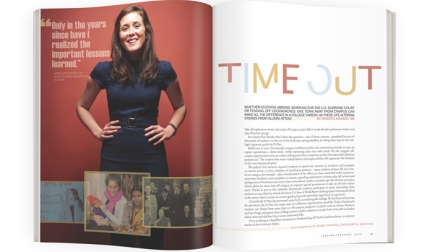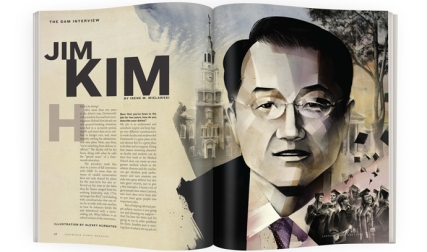“In the vernacular of the time, we were hot stuff,” says Dave Cook ’57.
The mid-1950s was a wonderful time to be young and playing hot jazz. The era saw a revival of traditional New Orleans-style jazz on Ivy League campuses, and the Dartmouth Indian Chiefs, with Cook on clarinet, were in the vanguard. The Dartmouth band went from success on the fraternity house circuit to swinging the Elbow Beach Surf Club in Bermuda and playing Carnegie and Symphony halls. They recorded an album, Chiefly Jazz, that was praised for its “gusto and imagination” by The New York Times’ jazz critic.
In December 1955, after performing on Steve Allen’s Tonight Show, the Indian Chiefs were invited to play at the show’s annual holiday party at the Plaza Hotel in New York City. “We had a grand jam session,” says Cook, recalling the members of the Tonight Show orchestra who sat in with them.
“The names absolutely floored us. Doc Severinsen played the trumpet with us. Allen, who had just finished playing the role of Benny Goodman [in a movie], played the piano. The conductor of the show orchestra, Skitch Henderson, was married to Faye Emerson, a very glamorous television personality. I distinctly remember her rolling up the rug and urging us to get going so they could dance.”
The band obliged—and played till 5 in the morning.
When the Chiefs started performing together nearly 60 years ago, a revival of 1920s-style “hot” jazz was under way on college campuses. “The music was both visceral and danceable,” the Riverwalk Jazz radio show reported in a 2008 program on “Classic Jazz in the Ivy League.” Almost every college had its own band that played hot jazz for mixers and parties: Princeton had the Tigertown Five, Yale had Eli’s Chosen Six, Harvard had the Crimson Stompers, Williams the Spring Street Stompers, and Hamilton the Catatonic Five.
Dartmouth’s Indian Chiefs included Cook, Peter Bullis ’54 on banjo, Larry Elliott ’57 on trombone, John Berge ’57 on piano, Alan Shapiro ’57 on trumpet, Clif Olds ’57 and Chuck Schroeder ’57 on drums, and Barry Bockus ’56 on string bass. “None of us majored in music,” says Cook. “We were simply eight liberal arts undergrads with the desire and ability to play jazz hot. It became in many ways the highlight of our Dartmouth experience and an inspiration for a life-time of music.”
Their repertoire of jazz standards, show tunes and original compositions had listeners bobbing their heads. “If you see people doing ‘chin music,’ as Elliott would call it, you know that they’re into it,” Cook says. At Dartmouth, 17 different fraternities hired the Chiefs to play, many houses more than once. The band also put thousands of miles on Schroeder’s car playing at campuses across the Northeast. “I did marvel at the distances we traveled to bring our music to colleges, from Maine to Michigan, Hanover to Washington, D.C., and Elmira Junior College to MIT, all in a beat-up station wagon,” Schroeder recalls.
Over spring break in 1955 the Chiefs played the Elbow Beach Surf Club. Bullis recalls how he and Elliott rode motorbikes each day to the Gosling Bros. liquor store in Hamilton to get refills of rum from great wooden kegs at $2 a quart bottle. That said, it was a more innocent age: Some of the “more modern musicians” in New York City might have been experimenting with drugs, but, Cook says, “We didn’t get into that.”
The Chiefs performed in charcoal gray flannel suits, which they felt gave them a more professional image than the red vests and straw hats often associated with Dixieland bands. Like New Orleans-style jazzman Wilbur de Paris’ band, which played at Jimmy Ryan’s, a club on 52nd Street in Manhattan, the Chiefs, too, played engagements at small clubs, including the Savoy Cafe in Boston’s South End and Ryan’s—where the management, sizing them up as college kids, tried to stiff them on pay. “We expected to get union scale, but we ended up getting $10 for the evening, and it was a long evening,” Cook says. “We went to the union and they squeezed Ryan’s to pay us. They never invited us back.”
On Thanksgiving weekends in 1955 and 1956, in the days when many Dartmouth undergrads spent the holiday in New York City, the Chiefs joined other college bands for midnight jazz shows at Carnegie Hall. Meantime, de Paris encouraged Elliott and Cook in their creative arrangements and original compositions, and his band joined the Indian Chiefs in a concert at Boston’s Symphony Hall in 1956.
“It was a fantastic ride, it really was,” Cook says. “We had no advance inkling we would be the success and win the acceptance we did.”
Certainly the Chiefs had the chops. Berge, a crowd favorite on piano, arrived at Dartmouth a classically trained musician who had mastered Beethoven’s Piano Concerto No. 1, recalls Cook, who lived in a neighboring dorm. “He also had a Hawaiian steel guitar, which he stuck in the window and played as loud as he possibly could. You couldn’t miss it for blocks. I heard that and said, ‘There’s a musician over there.’ ”
The group rehearsed regularly in spartan Room 201 in Hallgarten Hall, rented for $10 a semester. “We would come down after dinner most nights in the week and put in a couple hours,” says Cook. Bullis, the oldest member of the band, had decided to teach himself the banjo as a sophomore after a visit to New Orleans, where he fell in love with Dixieland jazz. “I decided I wanted to become part of the music,” Bullis says. When he joined, the die was cast that they would be a traditional jazz band. “How many modern bop bands had a banjo player?” asks Cook.
Shapiro says he often thinks back to those early days of the Chiefs. “Five freshmen got together in a rehearsal room and discovered they all had that rare ability to create melodies spontaneously and rhythmically, which is called ‘playing jazz,’ ” he says.
“My tastes in high school leaned toward Dizzy Gillespie, Miles Davis and Charlie Parker,” Shapiro says. “When I got to Dartmouth and met Larry and Dave, from New York and New Jersey, respectively, I learned about these New York clubs like Jimmy Ryan’s, Eddie Condon’s and Nick’s, where they played Dixieland. Thanks to their vision, I soon discovered this happy—or sad—pulsating music that made you feel good inside.
“My musical background when we formed the Chiefs was bebop. One of our first gigs was at Bennington College, where Larry’s sister Barbara was a student. At intermission Barbara came up to me and said, ‘Alan, don’t play so many notes.’ At that moment my style changed and I became a useful member of the Chiefs.”
The joy and gusto in their music may be heard on their album, Chiefly Jazz, recorded at Kresge Auditorium at MIT in March 1957 and reissued on compact disc in 1997 with the addition of three live tracks recorded in 1956 at Symphony Hall. The band’s favorite tracks include a rendition of “Body and Soul” that Bullis describes as “probably the best jazz side we ever made” and a live recording of “Royal Garden Blues” that conveys the spark between the band—especially pianist Berge—and the audience.
The Chiefs’ take on Dixieland drew from classical, show, Latin and folk music influences, says Bockus, who also played cello in the Dartmouth String Quartet. “We could not be pigeonholed into one genre of music,” he says.
On Chiefly Jazz traditional standards are joined by original compositions “Blues of the Emperor Jones,” “Barbados,” “The Joyous Advent of the Everything Machine” (all by Elliott) and “Last Year Blues” (by Cook), as well as arrangements of show tunes such as Cole Porter’s “Begin the Beguine” and “It’s All Right With Me,” Fritz Loewe’s “I Could Have Danced All Night,” George Gershwin’s “Embraceable You” and Jerome Kern’s “Ol’ Man River.”
“We concluded that the New Orleans style could and should encompass all and any music, provided that it swung,” Cook says.
Graduation and careers brought the Chiefs to an end in 1958. Elliott served as a B-52 navigator during a 20-year career in the Air Force. Berge is a mining geologist in Sweden. Schroeder is an investment executive in Chicago, and Cook is an investment counselor. Olds was a professor of art at Bowdoin College. Bockus, who balanced a banking career with playing string bass for a succession of jazz bands, is retired in Florida. Elliott, an electronics engineer, remains active in jazz. He is a composer and arranger, and Shapiro is musical director of the Dixie Diehards. Cook still plays and leads the Granite State Stompers. And Bullis, a retired architect, is banjoist and manager for the New Black Eagle Jazz Band, for 40 years one of the most acclaimed New Orleans-style groups in jazz and home now to Bockus as well.
The Indian Chiefs performed at the 30th and 40th reunions of the class of 1957, and they had their own 50th reunion in 2007. “The one thing I most appreciated about being a student at Dartmouth was being immersed, at a very important phase of life, in the company of so many bright—even brilliant—people. Foremost among these would be the Chiefs, whom I have long considered my best friends,” says Elliott. “The greatest reward came from knowing that the band was our own creation. We built it from scratch. Americans were viewing the future with a fervent optimism that has not occurred again, and may not ever. Even though ebullience is a natural attribute of youth, our music—and the band’s very existence—probably reflected that optimism, whether we knew it or not.”
Mark Sullivan has written for newspapers and college publications in New England. He currently works at Tufts University as an editor.
LISTEN TO THE INDIAN CHIEFS
All tracks are from “Chiefly Jazz 1956-1957,” comments by Dave Cook
Body and Soul
“Stands out for the extraordinarily high level of solo improvisation by the Chiefs across the board, but is especially notable for Larry Elliott's intensity of swing on his trombone solo.”
The Joyous Advent of the Everything Machine
“A delightful and catchy original by Elliott that quickly became our most requested selection.”
Beguine the Beguine
“John S. WIlson, jazz critic for The New York Times, praised our 1955 Carnegie Hall performance of this 109-bar non-traditional Cole Porter show tune for being venturesome, original and very effective.”




